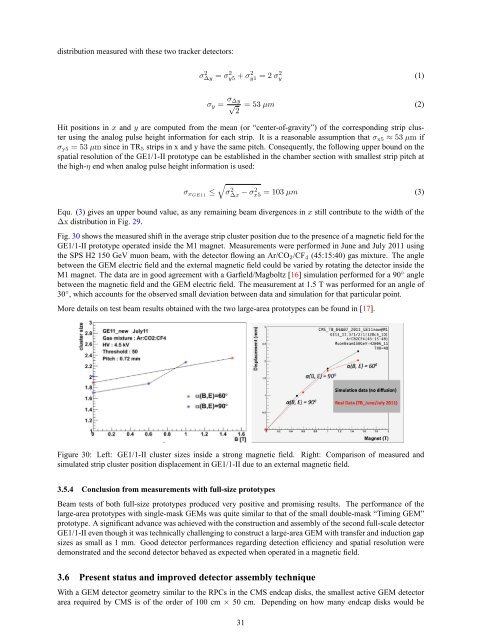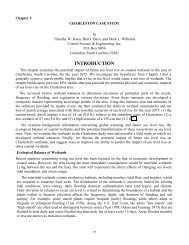A GEM Detector System for an Upgrade of the CMS Muon Endcaps
A GEM Detector System for an Upgrade of the CMS Muon Endcaps
A GEM Detector System for an Upgrade of the CMS Muon Endcaps
You also want an ePaper? Increase the reach of your titles
YUMPU automatically turns print PDFs into web optimized ePapers that Google loves.
distribution measured with <strong>the</strong>se two tracker detectors:<br />
σ 2 ∆y = σ 2 y5 +σ 2 y1 = 2σ 2 y<br />
σy = σ∆y<br />
√2 = 53µm (2)<br />
Hit positions in x <strong>an</strong>d y are computed from <strong>the</strong> me<strong>an</strong> (or “center-<strong>of</strong>-gravity”) <strong>of</strong> <strong>the</strong> corresponding strip cluster<br />
using <strong>the</strong> <strong>an</strong>alog pulse height in<strong>for</strong>mation <strong>for</strong> each strip. It is a reasonable assumption that σx5 ≈ 53 µm if<br />
σy5 = 53 µm since in TR5 strips in x <strong>an</strong>d y have <strong>the</strong> same pitch. Consequently, <strong>the</strong> following upper bound on <strong>the</strong><br />
spatial resolution <strong>of</strong> <strong>the</strong> GE1/1-II prototype c<strong>an</strong> be established in <strong>the</strong> chamber section with smallest strip pitch at<br />
<strong>the</strong> high-η end when <strong>an</strong>alog pulse height in<strong>for</strong>mation is used:<br />
σxGE11 ≤<br />
<br />
σ2 ∆x −σ2 x5 = 103 µm (3)<br />
Equ. (3) gives <strong>an</strong> upper bound value, as <strong>an</strong>y remaining beam divergences in x still contribute to <strong>the</strong> width <strong>of</strong> <strong>the</strong><br />
∆x distribution in Fig. 29.<br />
Fig. 30 shows <strong>the</strong> measured shift in <strong>the</strong> average strip cluster position due to <strong>the</strong> presence <strong>of</strong> a magnetic field <strong>for</strong> <strong>the</strong><br />
GE1/1-II prototype operated inside <strong>the</strong> M1 magnet. Measurements were per<strong>for</strong>med in June <strong>an</strong>d July 2011 using<br />
<strong>the</strong> SPS H2 150 GeV muon beam, with <strong>the</strong> detector flowing <strong>an</strong> Ar/CO2/CF4 (45:15:40) gas mixture. The <strong>an</strong>gle<br />
between <strong>the</strong> <strong>GEM</strong> electric field <strong>an</strong>d <strong>the</strong> external magnetic field could be varied by rotating <strong>the</strong> detector inside <strong>the</strong><br />
M1 magnet. The data are in good agreement with a Garfield/Magboltz [16] simulation per<strong>for</strong>med <strong>for</strong> a 90 ◦ <strong>an</strong>gle<br />
between <strong>the</strong> magnetic field <strong>an</strong>d <strong>the</strong> <strong>GEM</strong> electric field. The measurement at 1.5 T was per<strong>for</strong>med <strong>for</strong> <strong>an</strong> <strong>an</strong>gle <strong>of</strong><br />
30 ◦ , which accounts <strong>for</strong> <strong>the</strong> observed small deviation between data <strong>an</strong>d simulation <strong>for</strong> that particular point.<br />
More details on test beam results obtained with <strong>the</strong> two large-area prototypes c<strong>an</strong> be found in [17].<br />
Figure 30: Left: GE1/1-II cluster sizes inside a strong magnetic field. Right: Comparison <strong>of</strong> measured <strong>an</strong>d<br />
simulated strip cluster position displacement in GE1/1-II due to <strong>an</strong> external magnetic field.<br />
3.5.4 Conclusion from measurements with full-size prototypes<br />
Beam tests <strong>of</strong> both full-size prototypes produced very positive <strong>an</strong>d promising results. The per<strong>for</strong>m<strong>an</strong>ce <strong>of</strong> <strong>the</strong><br />
large-area prototypes with single-mask <strong>GEM</strong>s was quite similar to that <strong>of</strong> <strong>the</strong> small double-mask “Timing <strong>GEM</strong>”<br />
prototype. A signific<strong>an</strong>t adv<strong>an</strong>ce was achieved with <strong>the</strong> construction <strong>an</strong>d assembly <strong>of</strong> <strong>the</strong> second full-scale detector<br />
GE1/1-II even though it was technically challenging to construct a large-area <strong>GEM</strong> with tr<strong>an</strong>sfer <strong>an</strong>d induction gap<br />
sizes as small as 1 mm. Good detector per<strong>for</strong>m<strong>an</strong>ces regarding detection efficiency <strong>an</strong>d spatial resolution were<br />
demonstrated <strong>an</strong>d <strong>the</strong> second detector behaved as expected when operated in a magnetic field.<br />
3.6 Present status <strong>an</strong>d improved detector assembly technique<br />
With a <strong>GEM</strong> detector geometry similar to <strong>the</strong> RPCs in <strong>the</strong> <strong>CMS</strong> endcap disks, <strong>the</strong> smallest active <strong>GEM</strong> detector<br />
area required by <strong>CMS</strong> is <strong>of</strong> <strong>the</strong> order <strong>of</strong> 100 cm × 50 cm. Depending on how m<strong>an</strong>y endcap disks would be<br />
31<br />
(1)
















